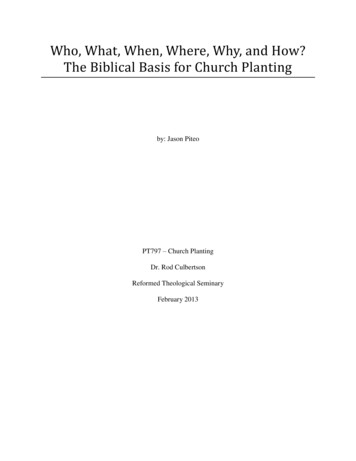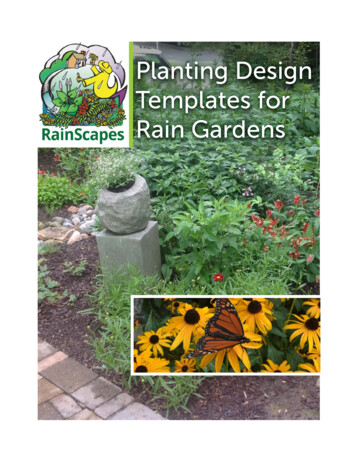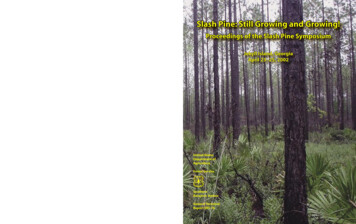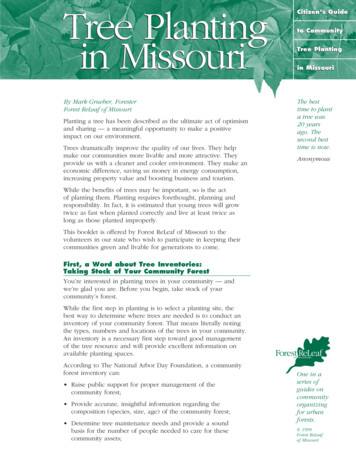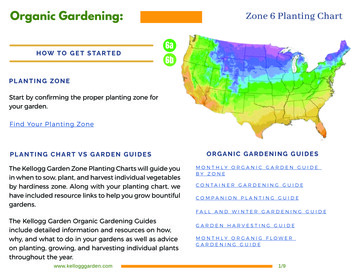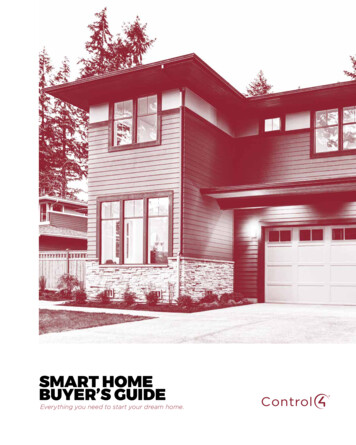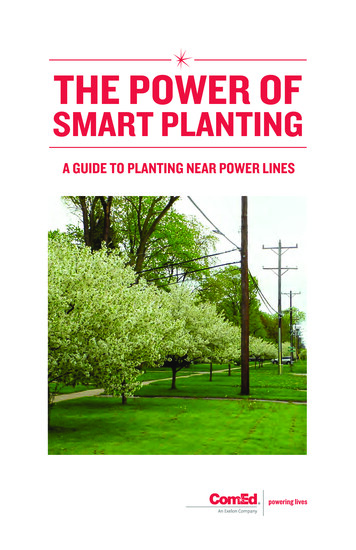
Transcription
THE POWER OFSMART PLANTINGA GUIDE TO PLANTING NEAR POWER LINES
Dear ComEd customer,This Power of Smart Planting booklet is a cooperative effortbetween ComEd and The Morton Arboretum. It’s a resource foryou when landscaping near power lines. With a little knowledgeand some direction, you can play a part in limiting power outages.Trees play a valuable role in our communities–they provideshade, wildlife habitat, and many other environmental benefits.However, tall trees that exist near power lines can threaten ourability to provide safe, reliable electric service. Approximately92% of tree-related interruptions are caused by seeminglyhealthy tree branches that have been broken and come intocontact with power lines running from pole to pole. High windsand storms can cause tree branches to break and fall onto lines,utility poles and other equipment, causing damage and serviceinterruptions.ComEd recommends planting low-growing trees and shrubs nearpower lines and keeping tall trees at a further distance. TheMorton Arboretum offers expertise in tree and shrub selection tohelp you choose vegetation that will work best around powerlines while adding beauty to your property. You’ll find plantingtips in this brochure that will help you successfully grow theseplants and bring more value to your property for years to come.An easy-to-read species guide is included in this brochure.To learn more about smart planting, visit ComEd.com/Trees.Additional plant information can be found at MortonArb.org.Sincerely,The ComEd Vegetation Management TeamThis publication contains general guidelines and is applicable only to overheadlocal distribution lines on wood poles. Neither ComEd nor the Morton Arboretumcan assume any responsibility for particular vegetation you plant. Please obey allcodes and act safely whenever you are near electric lines.2
A Short Tree is a Wise ChoiceWhen it comes to selecting the best tree to plant near power lines,think low-growing trees that mature at heights of less than 25 feet.Selecting the right trees will help you avoid power outages and willreduce the need for utility tree trimming in the future. If you areselecting trees that grow taller than 25 feet, consideration should begiven to the size and shape of the tree at maturity, as well as thelocation to nearby power lines. Tall trees that grow to more than 50feet at maturity should be planted furthest from the power lines.If you are selecting trees that grow taller than 25 feet, consideration should be given to the size andshape of the tree at maturity, as well as the location to nearby power lines.There are a number of low-growing species you can consider, withdifferent features and characteristics. Many of these trees havebeautiful flowers, colorful fruit, or interesting fall color. Consider thespace available for the tree and other site conditions, as well as themature height and width of your tree selection. Pages 4-5 contain asampling of interesting low-growing choices; however this is only ageneral reference overview. Feel free to visit MortonArb.org for moreinformation.3
A Selection of Beautiful Small TreesAnn Magnolia(Magnolia ann)Star Magnolia(Magnolia stellata)Growth Rate: SlowNative to: Hybrid originGrowth Rate: SlowNative to: JapanReddish-purple flowers appear in May beforethe foliage; sporadic blooming in mid-summer;medium green foliage; bronze-copper fall color;Good specimen tree for lawns and borders.Grown as multi-stem shrub; silvery-gray bark;fragrant white flowers appear in spring;attractive red fruit. Good in established gardens,sheltered locations, entryways or as a border.Red Buckeye(Aesculus pavia)Eastern Redbud(Cercis canadensis)Growth Rate: Slow-MediumNative to: Southeastern USGrowth Rate: MediumNative to: Midwestern and eastern USSmall multi-stemmed tree with dark greenfoliage; little color change in fall; carmine redflowers in May. Can be used as a specimen tree.Purplish-pink buds in early May; dark greenfoliage; yellow fall color; brownish-black bark onolder specimens. Attractive specimen tree or inwoodland gardens.4
Allegheny Serviceberry(Amelanchier laevis)Cornelian (Cherry) Dogwood(Cornus mas)Growth Rate: MediumNative to: Midwestern and eastern USGrowth Rate: Slow-MediumNative to: EuropeDark green foliage with distinctive red tinge;abundant white flowers in spring; small edibleberry-like fruit; fall colors vary from yellow toorange to red. Native tree great for naturalizing,and can be mixed with conifers.Yellow blossoms in late winter/early spring;red berries attract birds and squirrels; nice fallcolors. Good specimen tree or as a shrubborder.Kousa DogwoodAmerican Hornbeam(Cornus kousa)(Carpinus caroliniana)Growth Rate: Slow-MediumNative to: Japan, Korea, ChinaGrowth Rate: SlowNative to: Midwestern and eastern USWhite flowers appear in June; large raspberrylike fruit in August; dark green foliage; reddishpurple fall color; blooms 2-3 weeks after nativedogwoods. A good small specimen tree.Multi-trunked; blue-gray bark; foliage emergesreddish-purple, changing to dark green insummer and yellow-orange-red in the fall.Good understory tree or use as shrub border.5
Shrubs Make Beautiful SenseShrubbery can be used to screen your view of a neighbor’s back yard ordistract the eye from nearby power lines and other utility equipment.There are a number of attractive shrubs that can do the trick. Butdon’t plant too close to utility poles or equipment, as they can becomean obstruction for service crews that need to access ComEd equipment.Did you know More shrub speciesbloom in the springthan at any othertime of year.The shrubs in the species guideon pages 8-9 grow more thaneight feet tall and will providea good visual break betweenproperties. They also havebeautiful ornamental traits thatmake them smart choices whenlandscaping your home. Here isa sampling of several interestingchoices:Bottlebrush Buckeye (Aesculus parviflora)American Filbert (Corylus americana)Growth Rate: Slow-MediumNative to: Southeastern USGrowth Rate: Medium-FastNative to: Midwestern and eastern USLarge colony-forming shrub; dark green foliage;large white flower panicles appear in early July;golden yellow fall color. Excellent screen forwoodland or naturalized areas.Showy male flowers (catkins) are one of first toopen in early spring; medium green leaves turnorange-yellow in the fall; a frilly enclosed nutattracts birds and wildlife. Use in woodland andnaturalized settings.6
Fringetree (Chionanthus virginicus)Common Smokebush (Cotinus coggyria)Growth Rate: SlowNative to: Southeastern USGrowth Rate: MediumNative to: Southern Europe, central ChinaLight brown textured bark; medium-dark foliageemerges in spring; outstanding fragrance; 6” to8” long drooping clusters of white flowers openin late May-early June; male and female plantsproduce flowers but only females bear bluishfruit in September. Attractive specimen plant,excellent in groups, borders, or near buildings.Depending on cultivar, rounded leaves can bemaroon-red, purple or medium green; smallyellow flowers change to large billow-puffedpanicles that turn smoky pink to purplish pink insummer; in the fall their color can be reddishpurple to orange-red. Use as a specimen plant,in mass or hedge.Witch Hazel (Hamamelis virginiana)Seven Son (Heptacodium miconioides)Growth Rate: MediumNative to: Midwestern and eastern USGrowth Rate: Medium-FastNative to: ChinaLarge multi-stemmed shrub; irregular branchinghabit; dark green foliage turns yellow in fall andoften hangs on into winter; yellow, strap-like,fragrant flowers appear in late fall but are oftenhidden by the leaves. Use in naturalized areasand shrub borders.Small, suckering tree or large shrub; archingbranches; medium green leaves; yellow fall color;light tan exfoliating bark; small, fragrant whiteflowers August-October; in October, flower petalsdrop and sepals turn bright rosy-pink. Can beused as an accent, in borders, or in groupings.7
Smart Planting Species GuideSmall Deciduous Trees (i.e. Leafy Trees)Three-flowered MapleR20-25 20-25Red BuckeyeR10-20 15-18Allegheny ServiceberryApple ServiceberryFox Valley River BirchEuropean Hornbeam20-25 20-25O10-12 12-15N,C 15-20Special notesFall colorFruitFlowersLight RequiredTraits3U,O 20-25 15-18BSaltAlkaline soilPoor drainageTolerant toDroughtSpread (feet)Height (feet)Mature Size/ShapeShapeCommon name88-101American HornbeamO15-20 10-121-8Eastern RedbudR15-20 20-251-68White FringetreeS12-18Pagoda DogwoodH15-25 20-251-26-8Kousa DogwoodR15-20 15-201Cornelian-cherry DogwoodO15-25 10-12Japanese Cournel DogwoodR15-25 15-25Thornless Cockspur HawthornLWinter King HawthornL20-25 20-30R12-15 12-15Little Girl MagnoliaLoebner Magnolia8-15201566U,R 20-25 15-20Saucer MagnoliaO20-25 20-25Star Magnolia8-10O10-15Crabapple (select cultivars)R15-20 15-205-6Hoptree, Wafer AshV15-20 10-158Peking Lilac-China SnowR,S 20-2520Japanese Tree LilacO20-25 20-25YellowhornS18-249-101Special Notes:1.2.3.4.Requires well-drained soilsRequires high soil moistureProtection from afternoon sun recommendedFruit/cones produced only on female plantsYesNoIntermediate5.6.7.8.Full sunFruit of plant parts can be a nuisanceCan be prone to disease , insect pests and animal browsingCan sucker from root system and colonizeNative to the State of IllinoisPartial sunShadeShape: Upright Rounded Pyramidal Oval Columnar Vase shaped Spreading Broad Narrow Flat topped8
Evergreen TreesSpecial notesLight RequiredTraits10-258-104-8O10-258-106American ArborvitaeP6-253-182-6Western Red CedarP6-255-18Fall colorCWaterer Scotch PineFruit4Flowers8-10Salt10-25Alkaline soilCEastern Red CedarChinese JuniperDroughtSpread (feet)Poor drainageTolerant toHeight (feet)Mature Size/ShapeShapeCommon nameNote: Check individual cultivars for mature height.Tall Shrubs (over 8 feet)S8-128-15Shadblow ServiceberryU6-126-8Indigo BushR6-145-1088-108Bottlebrush BuckeyeAmerican Filbert or HazelO8-18Common SmokebushS10-15 10-15Forsythia (cultivars)U6-86-8Vernal Witch-hazelR6-156-10Common Witch-hazelR15-208-188Seven-Son FlowerU15-206-81Panicle HydrangeaV8-128-122American PlumS8-108-107-8Sargent CrabappleR6-128-15Northern BayberryS5-125-124Purpleleaf Sand CherryO7-107-101-8Smooth SumacS,F 10-15 10-15Staghorn SumacS,F 15-25 15-301-614-784-78Chinese LilacO8-108-101Common LilacR8-128-101Arrowwood ViburniumR5-9152-8NannyberryR15-186-128Blackhaw ViburnumO8-128-127-8Lantanaphyllum ViburnumC10119
Choosing The Right Tree Choose a tree that will fit the space. Go to ComEd.com/Trees for heightguidelines. Decide if you want single stem, multi-stem, fall color, seeds and/or blossoms. If road salt or salt spray will reach your tree, choose one that is salt tolerant. Make sure the tree you select is compatible with your soil conditions. Yoursoil might be predominantly wet, dry, clay, silt or sandy.Proper Preparation to Plant Be safe! You are required by Illinois law to call 811 to locate gas, electric,and telephone lines before you dig–and that includes when planting a tree.Contacting a power line with a shovel or pick can damage power lines–orworse–cause severe injuries or death. City of Chicago residents can callDIGGER (Chicago Utility Alert Network) at 312-744-7000. If you live outsideof Chicago, call J.U.L.I.E. (Joint Utility Locating for Excavators) at800-892-0123 or 811. You also can visit www.illinois1call.com. The hole you dig for your tree should be about 1” to 2" shallower and two tothree times wider than the root ball. Be sure the top roots are no more than2” to 3" below the root ball soil surface. Remove any excess soil. There should be no gap in the soil around the base of the trunk. If the ball is encased in a wire basket, remove at least the top third of thebasket. If the ball is wrapped in burlap and rope, remove them from the topof the root ball and the trunk of the tree. Cut any roots that are extending from the root ball, roots that may becircling a containerized tree, or other defective roots. Be sure to cut cleanlywith a sharp tool.Planting Correctly After placing the tree in the hole, fill the hole with soil removed from thehole and gently tamp it around the root ball. Consider mixing heavy claysoil with 10-15% organic matter. Water the soil so it settles firmly around the ball and moistens the root ball. Apply 2” to 3” of organic mulch to the top of the root ball but keep the mulch1” to 2” from the trunk. Mulch in contact with the trunk can cause the barkto become diseased or decay, injuring the tree. Prune out any dead or crossing branches.10
Watering Your Tree.Water new trees twice weekly for the first two years, especially if rainfall hasbeen inadequate. Amount will vary based on tree size. Trees with a 2” to 3"trunk diameter should be watered approximately 10 to 15 gallons twice perweek. During hot weather, more frequent watering may be needed.Did you know Trees located onthe west side ofyour home can bea natural windbreak and helpmoderate heatingbills during thewinter months.Remove container, wireor any wrapping fromroot ball, and place treeinto hole, on firmly packedsoil to prevent settling.Gently pack backfill aroundroot ball and soak with waterto settle soil. Place a 2” to 3”layer of mulch around tree,keeping the mulch 1“ to 2”away from the trunk.If support is needed, usetwo stakes and opposing,flexible ties, placed on thelower half of the tree, andallow trunk movement.If ComEd Needs to Trim TreesThere may be trees on your property that could interfere with power lines orother utility equipment. ComEd performs regular maintenance of trees nearpower lines and equipment.Electric utility tree trimming is often perceived differently from other typesof tree trimming because the objectives are different. However, the tools andmethods used are similar to those used by commercial tree care companies.Likewise, ComEd has certified arborists on staff to ensure that the trimmingadheres to the same professional standards as other arborists. ComEd employs“directional trimming” techniques to discourage the growth of sprouts thatcould grow into ComEd’s equipment, while also minimizing any stress on thetree. Directional trimming allows ComEd to take the characteristics of eachtree into consideration when determining the extent of triming needed.Trimming clearances are based on the growth rate and mature size and shapeof each tree, the location of the tree in relation to the power line, the type ofutility facility, and a cycle length of four years. Trees trimmed for power lineclearance may be significantly changed in appearance. Note that in some casescomplete tree removal may be necessary. Tall-growing trees directly underpower lines will require frequent trimming or they may cause ongoing powerinterruptions. It is also cost effective to remove the saplings of tall-growingtree species that are planted directly beneath power lines. While initiallysmall, they will quickly grow and cause a reliability and safety issue. ComEdfollows industry best practices when determining if tree removal is necessary.11
ComEd is committed to improving electric service reliability for itscustomers. Since 2001, ComEd has invested approximately 9 billionto expand, upgrade and maintain the reliability of its transmissionand delivery systems. Since 2001, ComEd has reduced the frequencyof customer interruptions by 20 percent. During that same time, theduration of those outages decreased by 3 percent.The Morton Arboretum is an internationally recognized outdoor treemuseum on 1,700 acres located in Lisle, Illinois. Plant collections,scientific research and education programs support the mission toplant and conserve trees and other plants for a greener, healthier andmore beautiful world.To obtain additional brochures, contact:The Morton Arboretum4100 Illinois Route 53Lisle, Illinois 60532MortonArb.org 2013 Commonwealth Edison Company. Printed on 10% post-consumer waste recycled paper.
distract the eye from nearby power lines and other utility equipment. There are a number of attractive shrubs that can do the trick. But don't plant too close to utility poles or equipment, as they can become an obstruction for service crews that need to access ComEd equipment. The shrubs in the species guide on pages 8-9 grow more than




